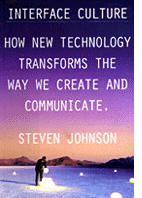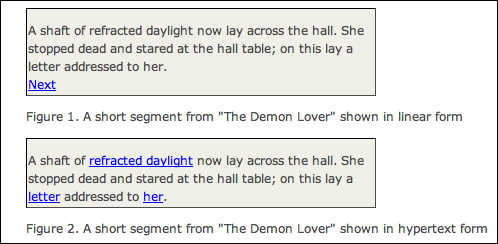 For 15 years, I’ve been doing most of my writing — aside from my two books — on the Web. When I do switch back to writing an article for print, I find myself feeling stymied. I can’t link!
For 15 years, I’ve been doing most of my writing — aside from my two books — on the Web. When I do switch back to writing an article for print, I find myself feeling stymied. I can’t link!
Links have become an essential part of how I write, and also part of how I read. Given a choice between reading something on paper and reading it online, I much prefer reading online: I can follow up on an article’s links to explore source material, gain a deeper understanding of a complex point, or just look up some term of art with which I’m unfamiliar.
There is, I think, nothing unusual about this today. So I was flummoxed earlier this year when Nicholas Carr started a campaign against the humble link, and found at least partial support from some other estimable writers (among them Laura Miller, Marshall Kirkpatrick, Jason Fry and Ryan Chittum). Carr’s “delinkification” critique is part of a larger argument contained in his book The Shallows. I read the book this summer and plan to write about it more. But for now let’s zero in on Carr’s case against links, on pages 126-129 of his book as well as in his “delinkification” post.
The nub of Carr’s argument is that every link in a text imposes “a little cognitive load” that makes reading less efficient. Each link forces us to ask, “Should I click?” As a result, Carr wrote in the “delinkification” post, “People who read hypertext comprehend and learn less, studies show, than those who read the same material in printed form.”
This appearance of the word “hypertext” is a tipoff to one of the big problems with Carr’s argument: it mixes up two quite different visions of linking.
“Hypertext” is the term invented by Ted Nelson in 1965 to describe text that, unlike traditional linear writing, spreads out in a network of nodes and links. Nelson’s idea hearkened back to Vannevar Bush’s celebrated “As We May Think,” paralleled Douglas Engelbart’s pioneering work on networked knowledge systems, and looked forward to today’s Web.
This original conception of hypertext fathered two lines of descent. One adopted hypertext as a practical tool for organizing and cross-associating information; the other embraced it as an experimental art form, which might transform the essentially linear nature of our reading into a branching game, puzzle or poem, in which the reader collaborates with the author. The pragmatists use links to try to enhance comprehension or add context, to say “here’s where I got this” or “here’s where you can learn more”; the hypertext artists deploy them as part of a larger experiment in expanding (or blowing up) the structure of traditional narrative.
These are fundamentally different endeavors. The pragmatic linkers have thrived in the Web era; the literary linkers have so far largely failed to reach anyone outside the academy. The Web has given us a hypertext world in which links providing useful pointers outnumber links with artistic intent a million to one. If we are going to study the impact of hypertext on our brains and our culture, surely we should look at the reality of the Web, not the dream of the hypertext artists and theorists.
The other big problem with Carr’s case against links lies in that ever-suspect phrase, “studies show.” Any time you hear those words your brain-alarm should sound: What studies? By whom? What do they show? What were they actually studying? How’d they design the study? Who paid for it?
To my surprise, as far as I can tell, not one of the many other writers who weighed in on delinkification earlier this year took the time to do so. I did, and here’s what I found.
You recall Carr’s statement that “people who read hypertext comprehend and learn less, studies show, than those who read the same material in printed form.” Yet the studies he cites show nothing of the sort. Carr’s critique of links employs a bait-and-switch dodge: He sets out to persuade us that Web links — practical, informational links — are brain-sucking attention scourges robbing us of the clarity of print. But he does so by citing a bunch of studies that actually examined the other kind of link, the “hypertext will change how we read” kind. Also, the studies almost completely exclude print.
If you’re still with me, come a little deeper into these linky weeds. In The Shallows, here is how Carr describes the study that is the linchpin of his argument:
In a 2001 study, two Canadian scholars asked seventy people to read “The Demon Lover,” a short story by the modernist writer Elizabeth Bowen. One group read the story in a traditional linear-text format; a second group read a version with links, as you’d find on a Web page. The hypertext readers took longer to read the story ,yet in subsequent interviews they also reported more confusion and uncertainty about what they had read. Three-quarters of them said that they had difficulty following the text, while only one in ten of the linear-text readers reported such problems. One hypertext reader complained, “The story was very jumpy…”
Sounds reasonable. Then you look at the study, and realize how misleadingly Carr has summarized it — and how little it actually proves.
The researchers Carr cites divided a group of readers into two groups. Both were provided with the text of Bowen’s story split into paragraph-sized chunks on a computer screen. (There’s no paper, no print, anywhere.) For the first group, each chunk concluded with a single link reading “next” that took them to the next paragraph. For the other group, the researchers took each of Bowen’s paragraphs and embedded three different links in each section — which seemed to branch in some meaningful way but actually all led the reader on to the same next paragraph. (The researchers didn’t provide readers with a “back” button, so they had no opportunity to explore the hypertext space — or discover that their links all pointed to the same destination.)
Here’s an illustration from the study:
Bowen’s story was written as reasonably traditional linear fiction, so the idea of rewriting it as literary hypertext is dubious to begin with. But that’s not what the researchers did. They didn’t turn the story into a genuine literary hypertext fiction, a maze of story chunks that demands you assemble your own meaning. Nor did they transform it into something resembling a piece of contemporary Web writing, with an occasional link thrown in to provide context or offer depth.
No, what the researchers did was to muck up a perfectly good story with meaningless links. Of course the readers of this version had a rougher time than the control group, who got to read a much more sensibly organized version. All this study proved was something we already knew: that badly executed hypertext can indeed ruin the process of reading. So, of course, can badly executed narrative structure, or grammar, or punctuation.
In both The Shallows and his blog post, Carr also makes reference to a meta-analysis (or “study of studies”) on hypertext reading studies, a paper that examined 40 other studies and concluded that “the increased demands of decision-making and visual processing in hypertext impaired reading performance.” But a closer look at this paper reveals another apples-and-oranges problem.
Carr is saying that Web links slow down our brains. But none of the studies the meta-analysis compiles looked at Web-style links. They all drew comparisons between linear hypertexts (screens with “next” links, not printed articles) on one side, and on the other, literary-style hypertexts broken up into multiple nodes where “participants had many choices in sequencing their reading.”
Every other study that I’ve looked into in this area shares these same problems; I’ll spare you the detail. These studies may help explain why there’s never been a literary-hypertext bestseller, but they don’t do much to illuminate reading on the Web. Carr talks about links having “propulsive force,” but does anyone really experience them that way today? Maybe in the early days of the Web, when they were newfangled, people felt compelled to click — like primitives suddenly encountering TV and jabbing their fingers at the channel selector, wondering what will magically appear next.
I think we all passed through that phase quickly. If your experience matches mine, then today, your eyes pass over a link. Most often you ignore it. Sometimes, you hover your mouse pointer to see where it goes. Every now and then, you click the link open in a new tab to read when you’re done. And very rarely, you might actually stop what you’re reading and read the linked text. If you do, it’s usually a sign that you’ve lost interest in the original article anyway. Which can happen just as easily in a magazine or newspaper — where, instead of clicking a link, we just turn the page.
Yes, a paragraph larded up with too many links can be distracting. Links, like words, need to be used judiciously. This is a long post and I have included only a modest number of links — all that I needed to point you to my sources and references, and most of which most of you won’t ever click. Overuse of links is usually a sign that the writer does not know how to link, which on the Web means he does not know how to write. But such abuse hardly discredits linking itself. Many writers still don’t understand that comma-splicing is bad grammar, but does that get us talking about the “de-comma-fication” of our prose?
 For Carr and his sympathizers, links impede understanding; I believe that they deepen it. Back in 1997 Steven Johnson (in his book Interface Culture) made the case for links as a tool for synthesis — “a way of drawing connections between things,” a device that creates “threads of association,” a means to bring coherence to our overflowing cornucopia of information. The Web’s links don’t make it a vast wasteland or a murky shallows; they organize and enrich it.
For Carr and his sympathizers, links impede understanding; I believe that they deepen it. Back in 1997 Steven Johnson (in his book Interface Culture) made the case for links as a tool for synthesis — “a way of drawing connections between things,” a device that creates “threads of association,” a means to bring coherence to our overflowing cornucopia of information. The Web’s links don’t make it a vast wasteland or a murky shallows; they organize and enrich it.
“Channel surfing,” Johnson wrote, “is all about the thrill of surfaces. Web surfing is about depth, about wanting to know more.” As the Web has grown vast, that desire has grown with it. To swear off links is to abandon curiosity. To be tired of links is to be tired of life.
Tomorrow, in the next post in this series, I’ll examine some of the ways links are being misused on the Web today — driven not by some abstract belief in the virtues of hypertext but rather by crude business imperatives. Then, in the final installment, I’ll make the case for good linking practices as a source of badly needed context and a foundation for trust.
This is part one of a three-part series. The second part is Money changes everything. The third part is In links we trust.
Post Revisions:
- August 26, 2019 @ 18:33:22 [Current Revision] by Scott Rosenberg
- August 26, 2019 @ 18:33:20 by Scott Rosenberg
- September 1, 2010 @ 09:34:59 by Scott Rosenberg
- August 31, 2010 @ 06:46:13 by Scott Rosenberg
- August 30, 2010 @ 06:52:22 by Scott Rosenberg
- August 30, 2010 @ 06:48:06 by Scott Rosenberg
- August 30, 2010 @ 06:22:50 by Scott Rosenberg

